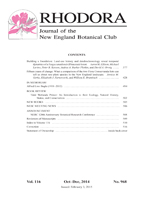Flora Conservanda is a list of native plant taxa considered to be most rare in New England. Originally published in 1996, the list was updated in 2012. The updated list includes 593 taxa in five divisions: 62 in Division 1 (Globally Rare), 325 in Divisions 2 and 2(a) (Regionally Rare), 57 in Division 3 (Locally Rare), 96 in Division 4 (Regionally Historic), and 53 in Division IND. (Presumed Rare, but confirmation required). Since the first publication of the list, substantial changes have occurred both in the landscape and in our understanding of the taxa. Here, we compare the 2012 update to the original list, noting changes in the species assigned to each division and recording the reported number of extant populations (Element Occurences) in each state. We assessed trends in rarity during the intervening 15 years among 676 taxa in one or both lists, and identified further data collection that would be beneficial. One hundred and thirty-seven taxa were new to the list in 2012. The numbers of reported extant occurrences increased for 118 taxa and declined for 40 taxa since the 1996 publication; 10 taxa declined in one or more states and increased in others. Little net change in occurrence numbers was seen for 213 taxa, and trend data were insufficient to assess population trends for 295 taxa. Massachusetts (55 or 18.4% of MA listed taxa), Connecticut (55 or 18.4%), and Maine (46 or 16.9%) had the most taxa with increased numbers of occurrences, and Massachusetts (22 or 7.7%), Maine (20 or 8.3%), and New Hampshire (17 or 8.4%) had the most taxa with decreased occurrence numbers. Increased occurrence numbers were more common among those taxa characteristic of shores and banks, wetlands, and forests, whereas higher proportions of declining species were characteristic of coastal, alpine, and exposed rocky areas. A significantly higher proportion of entomophilous species showed occurrence declines than increases. Overall, the magnitude and distribution of noted changes may be due to the success of concerted efforts to seek out previously overlooked populations, range expansions of certain taxa, or validation of older records. Trends apparent in the Flora Conservanda data can be used to prioritize regional conservation actions and data collection.
How to translate text using browser tools
22 December 2014
Fifteen years of change: What a comparison of the two Flora Conservanda lists can tell us about rare plant species in the New England landscape
Jessica M. Gerke,
Elizabeth J. Farnsworth,
William E. Brumback
ACCESS THE FULL ARTICLE

Rhodora
Vol. 116 • No. 968
October 2014
Vol. 116 • No. 968
October 2014
biogeography
conservation
functional groups
habitat
New England
pollination
range shifts




